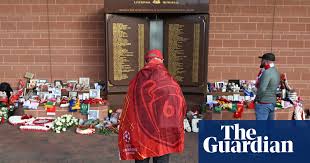OJ Simpson murder trial: How the case that gripped the US unfolded

Former American footballer and actor OJ Simpson, who has died of cancer, will be remembered most for his role at the centre of the "trial of the century".
Accused of double murder, his case captured the attention of the US until it came to a dramatic end in late 1995.
Here's a look back at how that trial unfolded.
12 June 1994
Simpson's ex-wife Nicole Brown Simpson was found dead in front of her home in Los Angeles with her friend Ronald Goldman, who was a waiter at a restaurant where she had just dined.
The pair had been stabbed to death outside her home in the neighbourhood of Brentwood.
Read more:OJ Simpson has died at the age of 76, his family says

17 June 1994
After the bodies were found, suspicion quickly fell on Simpson, who had been married to Nicole for seven years until their divorce became final on 15 October 1992, little more than 18 months before her death.
Simpson had been ordered by prosecutors to surrender, but on this day, carrying a passport and a disguise, he instead fled, with friend and former team-mate Al Cowlings in a white Ford Bronco.

The vehicle was soon spotted on a California freeway and pursued by police in a car chase that was televised live across the country and watched by an estimated 95 million viewers.
Cowlings, in a phone call to police, said Simpson was lying in the back seat of the car holding a gun to his own head. After eventually driving to his Brentwood home he was persuaded to surrender.
Sky News' Steve Bennedik recalls how Simpson's trial was covered
It was the first few weeks of 1995 when Sky News' live coverage of the OJ Simpson court case got under way. Each evening we showed the trial and invited questions. In those days, the main form of correspondence was by letter.
But there was also a new electronic method emerging, called email. And the first of these had the simple, but deflating, sentence: "Which one is OJ?"
We asked ourselves: Is our audience ready to follow the story of a very American tragedy unfold on British TV? We decided to stick with it.
In contrast, OJ Simpson was a household name in the US. So much more than an ex-football star. But the shock of this icon being arrested for murder, the bizarre Bronco highway chase, the high-profile celebrity defence team, and ultimately the "did he do it?" question had universal attraction.
Although the case stuttered through until October, the weak Judge Lance Ito was obsequious to lawyers' demands for delays, but the interest among Sky News viewers surged and remained undimmed.
As the court camera panned to the state of California seal, signalling another adjournment, we and no doubt the viewer sighed.
More behind-the-scenes legal wrangling, but we had an ace up our sleeve - Professor Gary Solis. Gary is a Vietnam veteran, former military judge advocate, with alma maters including George Washington University and the London School of Economics.
At the time, he was in London and ready to give up his evenings. He calmly steered our presenters, Laurie and Vivien, and our often puzzled viewers through the complexities of the Californian legal system and became a firm favourite with the newsroom and the public alike.
The court characters emerged. Marcia Clark and Christopher Darden for the prosecution, and the "Dream Team" defence – Jonnie Cochran, F Lee Bailey, Alan Dershowitz and Robert Kardashian, whose children would go on to outshine his fame.
It was compelling court drama, but it was also the very tragic story of two young people who'd been savagely attacked and murdered, with their families devastated by the loss, and tormented by the lingering back and forth court battle.
The proceedings had lasted months, but the jury reached their verdict in just a few hours and when they returned to the courtroom to deliver it, an early evening audience in the UK was hanging on every moment. And then it was over. OJ was a free man.
The People of the State of California v Orenthal James Simpson faded as a memory, flickering back to life with the news of his death.
24 January 1995
The murder trial, dubbed the "trial of the century" by the media, began.
Prosecutors argued OJ Simpson had killed Nicole and Ron in a jealous rage, and they presented extensive blood, hair and fibre tests linking him to the murders.

Keep up with all the latest news from the UK and around the world by following Sky News
Tap hereThe defence countered that the celebrity defendant was framed by racist white police.
15 June 1995
Perhaps the defining moment of the trial came on a Thursday in June, when the prosecution committed what a defence lawyer would later describe as the "greatest legal blunder of the 20th century".

On this day, a prosecutor asked him to put on a pair of gloves believed to have been worn by the killer.
The gloves appeared to be too small, as OJ Simpson struggled to put on the gloves in a highly theatrical demonstration and indicated to the jury they did not fit.
Read more:OJ Simpson a 'completely free man' after being released from parole
This led defence lawyer Johnnie Cochran to famously state in his closing argument: "If it doesn't fit, you must acquit."
3 October 1995
The trial came to an end with two words - not guilty.
OJ Simpson, who maintained from the outset he was "absolutely 100% not guilty", waved at the jurors and mouthed the words "thank you".


 United Kingdom
United Kingdom Argentina
Argentina  Australia
Australia  Austria
Austria  Brazil
Brazil  Canada
Canada  Germany
Germany  Ireland
Ireland  Italy
Italy  Malaysia
Malaysia  Mexico
Mexico  New Zealand
New Zealand  Poland
Poland  South Africa
South Africa  United States
United States 







































